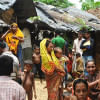276,200 Myanmar refugees in Bangladesh
The number of refugees from Myanmar rose to 490,300 by the end of last year, up from 451,800 in the previous year, with Bangladesh hosting the largest number of 276,200, says a new global report.
Out of the 276,200 refugees, 243,000 are in a refugee-like situation, according to the report published yesterday by UNHCR ahead of the World Refugee Day today.
The Bangladesh government, however, estimates the population to be between 300,000 and 500,000.
Other countries with large numbers of Myanmar refugees included Thailand (102,600), Malaysia (87,000), and India (15,600), said the report.
It said war, violence and persecution worldwide were causing more people to be forcibly displaced now than ever before.
The UN refugee agency's new Global Trends report, the organisation's major annual survey of the state of displacement, said 65.6 million people were forcibly displaced worldwide last year, some 300,000 more than a year earlier.
The total represents an enormous number of people needing protection worldwide.
The figure of 65.6 million comprises three important components, including 22.5 million refugees, the highest ever number.
"By any measure this is an unacceptable number, and it speaks louder than ever to the need for solidarity and common purpose in preventing and resolving crises, and ensuring together that the world's refugees, internally displaced and asylum seekers are properly protected and cared for while solutions are pursued," said UN High Commissioner for Refugees Filippo Grandi.
"We have to do better for these people. For a world in conflict, what is needed is determination and courage, not fear," he added
The report found that new displacement in particular remains very high.
Of the 65.6 million people forcibly displaced globally, 10.3 million became displaced last year, about two-thirds of them (6.9 million) fleeing within their own countries. This equates to one person becoming displaced every 3 seconds.
At the same time, return of refugees and internally displaced people to their homes, combined with other solutions such as resettlement in third countries meant that for some, 2016 brought the prospect of improvement. Some 37 countries together accepted 189,300 refugees for resettlement.
Around half a million other refugees were able to return to their home countries, and about 6.5 million internally displaced people to their areas of origin, although many did so in less than ideal circumstances and facing uncertain prospects.
Worldwide, 84 percent refugees were in low- or middle-income countries as of end of 2016, with one in every three (4.9 million people) being hosted by the least developed countries.
This huge imbalance reflects several things, including the continuing lack of consensus internationally when it comes to hosting refugees and the proximity of many poor countries to regions of conflict.
It also illustrates the need for countries and communities supporting refugees and other displaced people to be robustly resourced and supported, the absence of which can create instability, have consequences for lifesaving humanitarian work, or lead to secondary displacement.
By population, Syria still accounts for the biggest number of displaced people overall, with 12 million people (almost two thirds of the population) either displaced internally or having fled abroad as refugees or asylum seekers.
UNHCR produces its Global Trends report annually based on its own data, the data it receives from its partner the Internal Displacement Monitoring Centre, and also from governments.

 For all latest news, follow The Daily Star's Google News channel.
For all latest news, follow The Daily Star's Google News channel. 




Comments